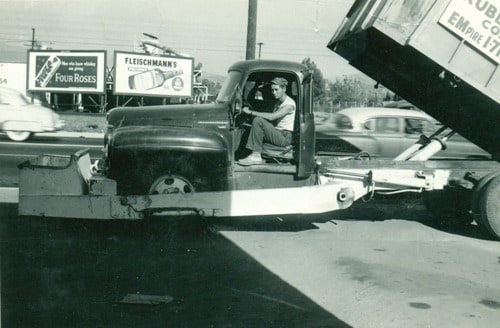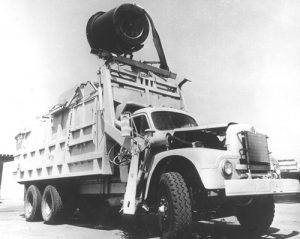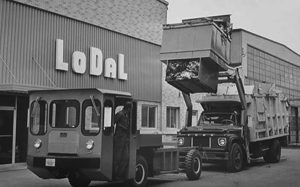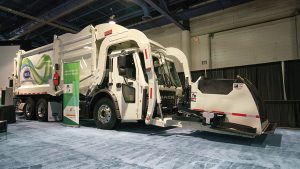Discussing the close ties and history between the front loader and residential collection.
This year at the Waste Expo, we saw Heil Environmental unveil the new “Gen-3” version of their Odyssey Residential Front Loader. The key feature of their new body included a new arm into which the Curotto-Can was completely integrated making it non-removable. After Heil acquired The Curotto-Can in 2013, I had a feeling this was going to be the eventual evolutionary step in Heil’s push and marketing strategy to create a pure residential front loader. When I saw the new Odyssey and how they integrated the Curotto-Can, my mind went straight back to California in the 1950s where the front load concept was originally born and put into practice. This Heil truck gave me the initial inspiration for writing this article and to explain how closely tied the history of the front loader is to modern residential collection practices.

For decades, the front loader has been a powerful commercial collection truck and the staple of any fleet across the country. Yet, in 1952 when it was originally designed, its sole application was for residential collection. Designed by Phil Gentile and S. Vincen Bowles in Los Angeles, it featured a straight arm that broke in the middle with a 1-yard bucket permanently attached to the end that rested just off the end of the bumper. Offering an extremely low loading height of 18 inches, the bucket was emptied into an open top dump box. The first 10 bodies were made by Bowles for Gentile’s company United Rubbish Co. Quickly evolving within the next year for commercial collection using detachable containers left at businesses, residential use was still going to be a big aspect of its application even though it had now found its main calling. Many haulers west of the Rockies in the 1950s preferred the front loader for residential collection because of the low loading height and the fact that in two man operations, the driver always had visibility of the helper. The hauler also had access to packer bodies typically bigger than rear and side load offerings of the day and with a removable carry bin; it also gave them a dual purpose truck for commercial collection. This trend took hold and today is still the practiced method of collecting residential waste in many areas throughout the country due to the generational concept of “That’s how we’ve always done it and it works!”
For the first few years of its infancy, Bowles made residential front loaders with an integrated bin on the end of the arms and, through distributors, marketed this system coast to coast. In 1955, Dempster Brothers got into the front load market after seeing success with their dumpster system introduced in 1937. While their first offering was simply an arm attached to another manufacturer’s side load body, it would take several years before they offered their own pure Dempster Dumpmaster Front Loader. However, the Dempster Company focused more on the commercial application of their products until the 1960s when advertisements came out with residential options for their front loaders. Through their extensive marketing and distribution network east of the Rockies, Dempster Company was able to introduce their various systems to a large market area.
The “Trash Train”

During the 1960s, another concept in residential collection surfaced which caught on in many areas around the country called the “Trash Train.” A simple system which included several 4 to 6 yard front load containers, they were fitted with axles, hitched together and pulled by a light duty truck or pickup. Using a crew of two to three people or “swampers”, the Trash Train would drive through the neighborhoods where the swampers would fill the containers up from both sides of the street or alleys. Once the containers were full, the crew would either meet at a designated location or on route where a front loader often called the “Mother Truck” would empty the containers so the crew never had to leave the collection area. This system allowed the crews to stay productive on route with the front loader making the often-long drive to the landfill, thereby saving time and fuel. One front loader could service several crews while picking up commercial stops before having to go dump out. Compared to a standard rear loader used for residential collection, the Trash Train system had a significantly lower investment, maintenance and operating cost to the hauler versus having to buy and maintain a fleet of packer trucks.
Many manufacturers including Dempster, Cobey and Lodal offered complete “Trash Train” packages with their containers, however Lodal took the concept one step further in 1968. One downside of the train system was that the trash was still loose in the bins and not compacted, requiring many containers to make it useful in neighborhoods before having to meet up with the front loader. Lodal sought to rectify this drawback and created a revolutionary product called the EVO side loader. Featuring the first successful unitized, chassis-less refuse collection vehicle, it had a detachable 8 yard body, which could either be dropped off at a centralized location and a fresh one loaded or emptied on route by a Lodal Front Loader with their unique single point connector. The EVO offered front wheel drive with an automatic transmission and was able to maximize the payload through even weight distribution over two axles thanks to the chassis-less construction. Since the hopper was part of the overall frame, it offered exceptionally low loading height even when compared to the drop frame Shu-Pak side loaders. After the train system fell out of favor in the late 1970s, Lodal fixed the body to the frame and offered sizes up to 25 yards on three axles.
The Birth of Automated Side Loaders?

While I am going to write about the history of automated side loaders in a future article, I would like to take a minute to point out that the first automated truck was created through modifying a Lodal Load-a-Matic Front Loader by the City of Scottsdale. You might have heard about it; it was called Godzilla. After testing and verifying the proof of concept, a more refined version was realized by working with Western Body and Hoist and modifying their Wesco-Jet Front Loader with a telescoping arm. Western made over a dozen of these, dubbed the Son of Godzilla, for the City of Scottsdale. Western was bought by Maxon Industries in December of 1970 and they agreed to honor the contract with the City for the remaining two trucks but were not interested in continuing the further development. But more on this later.
In the late 1980s, automated side load technology was still developing and manual collection ruled the country. Waste Management Incorporated (WMI) realized the power of using a front loader for residential collection but wanted to take the concept to the next level. Looking across the pond, WMI saw the Multi-Service Transport System (MSTS) designed by Gustav Edelhoff and Fred T. Smith. Fred Smith designed many of the Gar Wood packers of the 1970s and was well known in the industry. Under a licensing agreement, Heil Environmental started making the MSTS for WMI in 1989, calling it the Heil POD. Consisting of a low-entry truck to which a pair of container lift arms were attached, the packer blade and hopper were self-contained behind the cab. The actual storage body was itself detachable, so that when filled it could be disconnected and replaced with an empty unit. This allowed the collection truck to continue rounds while a transport tractor hauled multiple containers to the disposal point. Used across many Waste Management sites throughout the country for almost a decade, it started getting phased out after WMI merged with USA Waste in favor of traditional automated side load trucks.
Full Circle

In the late 1990s, with automated technology becoming more mature, the next logical evolution for front loader use in residential collection was to create an automated can. This concept appealed to many companies who already had an established system but did not want to make the investment to go automated by replacing their entire fleet. It kept the benefits of driver visibility, being able to see when contamination enters the carry container, a larger capacity body and a backup truck for their commercial fleet. The automated cans also had a shorter cart dumping cycle time compared to the full size automated trucks, which could theoretically cut down time on route. While several companies attempted to develop and market an automated can, including Heil and Kann Manufacturing, the Curotto and Perkins Cans’ are probably the most well-known today.
It is funny to see how things come full circle in this industry. Sixty-six years after the first front loader was invented, the original concept is fully re-imagined—even if the engineers did not know they were doing it. The concepts our fathers and grandfathers drafted but could not make reality either due to technology constraints or the industry not being ready, has now become reality. Maybe there are no new ideas for waste collection? Is this a bad thing or have we just gotten to the point where the proven designs just become stronger and upgraded?
Zachary Geroux is a photographer, videographer, historian and owner of Refuse Truck Photography which focuses on media and marketing for the Waste Industry. He lives in Western Washington with his wife and newborn son who will soon fall in love with garbage trucks. Currently, he works full time for the Air Force, is focused on growing his business and has been driving garbage trucks off and on for the past 10 years. He can be reached at (541) 301-1507, e-mail [email protected] or visit www.refusetruckphotography.com.
*Any company mentioned or discussed is not meant as a free advertisement or endorsed by the magazine. This is a wholly independent, historical and educational article.
